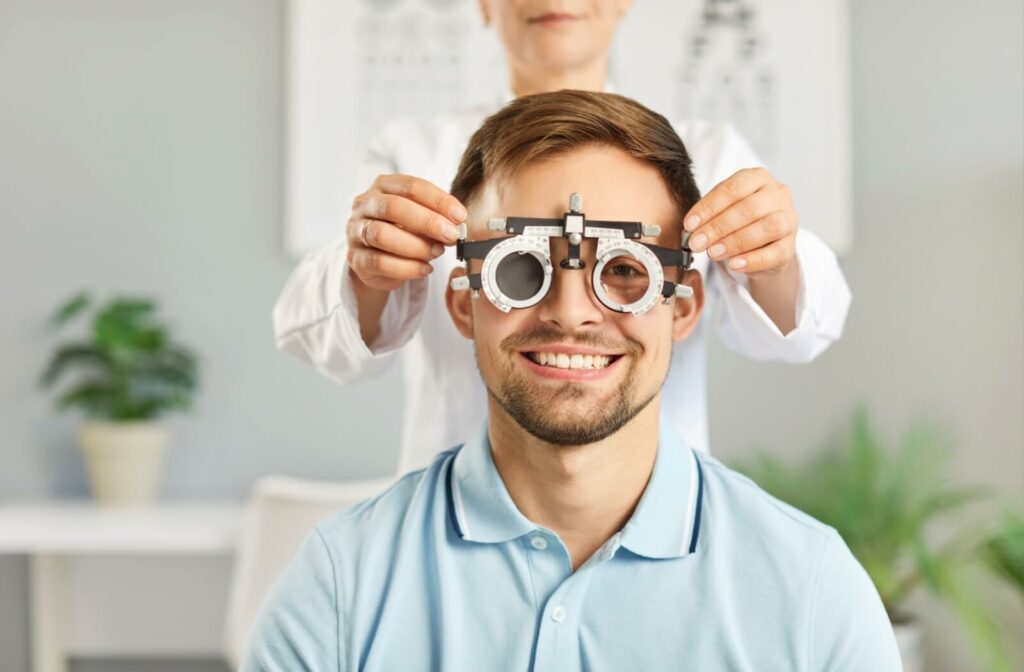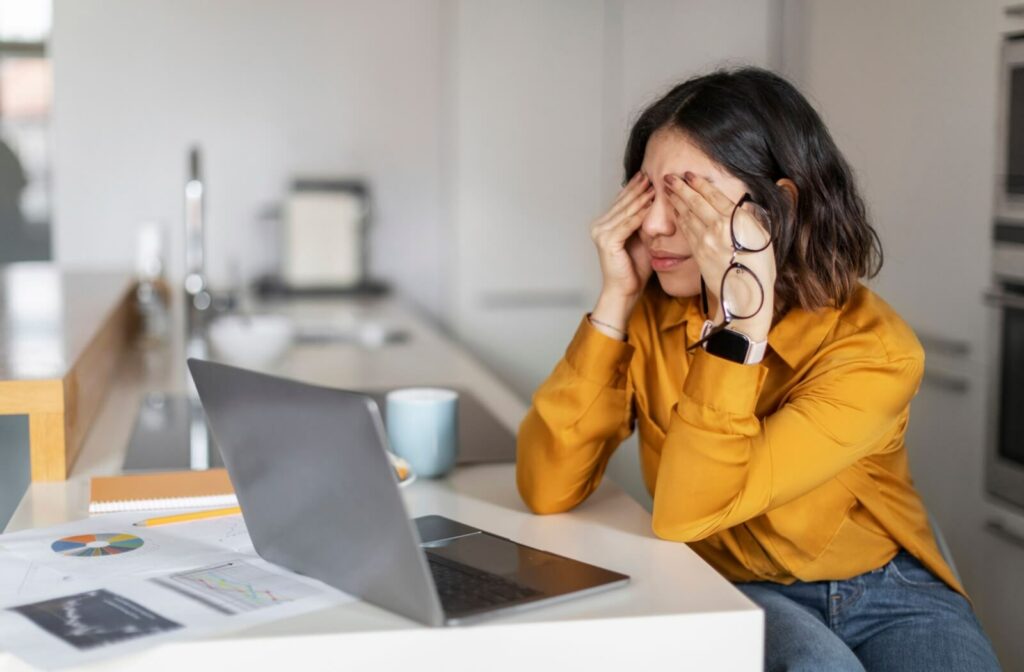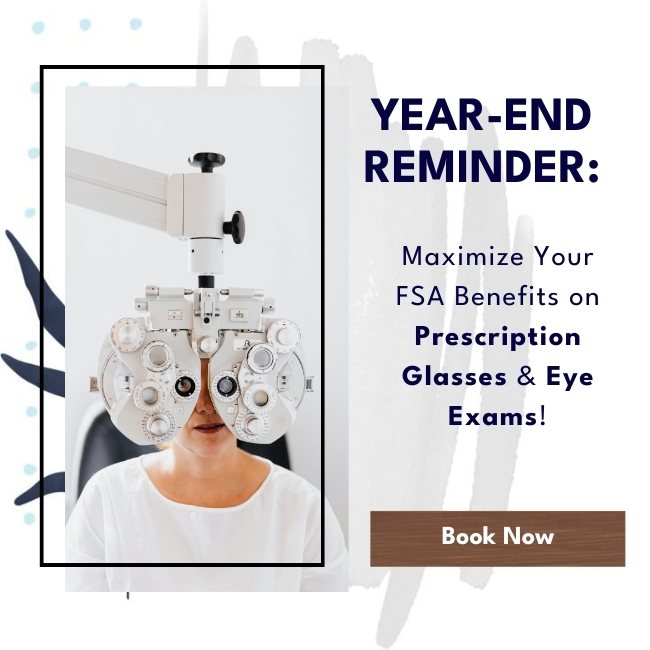In our screen-heavy world, eye strain has become something most of us deal with—whether after a long day of work, scrolling through social media, or binge-watching a favorite show. But when your eyes start feeling tired, dry, or just plain uncomfortable, it’s natural to wonder: How long is this going to last?
The short answer? Eye strain typically lasts a few hours but may stick around for days in more persistent cases. Your experience with strained, tired, or dry eyes depends on how hard your eyes are working and contributing factors, including conditions like dry eye.
The good news is, with the right care and attention, you can shorten that timeline and prevent future flare-ups.
What Exactly Is Eye Strain?
Eye strain, or asthenopia, happens when your eyes get overworked, usually from focusing too hard or too long. It’s not considered a disease or a serious condition, but it can add distraction and frustration to your daily life.
You’re most likely to experience eye strain during tasks that demand sustained visual attention, like reading, driving, or spending hours at a computer. The discomfort is your eyes’ way of saying they need a break.
Common Symptoms of Eye Strain
Eye strain can show up in different ways. Some people might only experience a few symptoms, while others deal with a whole combination. Common signs include:
- Tired, heavy, or strained eyes
- Dry or watery eyes
- Blurry or double vision
- Headaches or neck & shoulder strain
- Frequent squinting to help focus
- Sensitivity to light
If you’ve felt these symptoms after a long period of screen time or close-up work, your eyes are likely telling you they’re fatigued.
What Affects How Long Eye Strain Lasts?
How long your symptoms linger can vary, depending on several factors:
- How severe is the strain?
- Mild eye fatigue can go away in a few hours
- Intense symptoms might stick around 1–2 days
- Do you have underlying vision problems?
- Conditions like uncorrected nearsightedness, astigmatism, or dry eye can make symptoms last longer
- What habits are contributing to strain?
- Habits & environmental factors like poor posture, bad lighting, & inadequate breaks can contribute to how long your eyes feel strained
Common Causes of Eye Strain
The most common reasons you might experience eye strain are extended screen time, poor lighting, and intense focus without a break.
1. Screen Time Overload
Digital devices are a major culprit of frequent eye strain. Our eyes work harder to focus on screens, especially with small fonts and bright backlighting.
Your blink rate drops drastically when you stare at a screen, exposing your eyes to dry air, blue light, and uninterrupted focus.
2. Poor Lighting Conditions
Whether you’re working in a dim room or a space with harsh overhead lighting, your eyes have to compensate, leading to more strain. Screens, windows, or shiny surfaces can create glare, requiring your eyes to work harder to focus.
3. Prolonged Focus
Any task that keeps your eyes focused without a break, like reading, crafting, or driving, can wear out your eye muscles.
Your eyes often focus on these tasks for an hour or more without a break—imagine staying in a squat position or holding your arms up for that long! Even a simple shift of focus can help prevent the fatigue of prolonged focus.

Simple Ways to Relieve Eye Strain
The key to relieving eye strain is giving your eyes the needed rest and support. Try these easy tips.
Blink More Often
Screen use often makes us blink less, which can dry out the eyes. Make a conscious effort to blink regularly to keep your eyes moist and refreshed.
Follow the 20-20-20 Rule
Every 20 minutes, look at something 20 feet away for 20 seconds. It’s a small habit that makes a big difference.
Adjust Your Workspace
Keep your screen at eye level, about 20–28 inches from your face. Reduce glare with proper lighting or an anti-glare filter.
Use Artificial Tears
Over-the-counter lubricating drops can soothe dryness and irritation. Choose preservative-free options and use them as needed.
When Should You See an Eye Doctor?
Most cases of eye strain go away on their own with rest and simple adjustments. But if your symptoms last longer than a couple of days or the discomfort worsens, it’s time to check in with an optometrist.
Some red flags to watch for:
- Eye strain that doesn’t improve with breaks
- Frequently needing eye drops for severe dryness
- Significant vision changes or difficulty seeing clearly
- Frequent headaches or dizziness
- Light sensitivity that feels excessive
In some cases, ongoing eye strain can indicate uncorrected vision issues, the need for a new prescription, or dry eye disease.
Tips for Preventing Future Eye Strain
While you can’t always avoid screen time, you can build habits that help protect your eyes over the long haul:
- Limit continuous screen time by taking breaks, switching tasks, or stepping away when you can
- Use dark mode or night mode in the evenings to help reduce blue light exposure, glare, or straining to see
- Create an ergonomic setup with screens at the right height & distance, plus a comfortably aligned posture
- Stay hydrated by drinking plenty of water, especially in dry environments, & try preservative-free eye drops
- Get regular eye exams to keep your prescription up-to-date & get professional guidance to prevent ongoing discomfort
Eye Strain in the Age of Digital Living
From virtual meetings to endless emails to streaming entertainment, modern life keeps our eyes constantly working. But that doesn’t mean you have to live with the discomfort of eye strain.
With a few mindful changes and a little self-care, your eyes can feel relief faster—and stay that way longer. And if things aren’t improving, don’t tough it out.
At Eyedeal Eyecare, we can help you protect your vision and find relief from digital eye strain. Whether you need a comprehensive eye exam, guidance for healthier screen habits, or personalized dry eye treatment, schedule your appointment today with our team.




